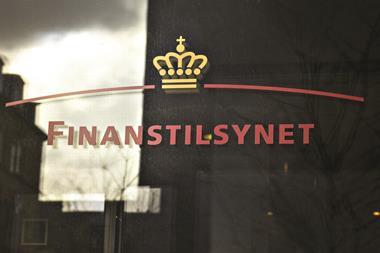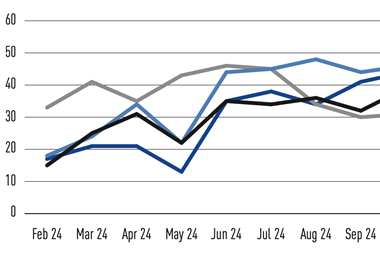Within the coming weeks it will become evident whether the experiment of using the severance pay reserves known as TFR to give the kiss of life to Italy’s pension system has worked. The TFR is a payment that all companies give to employees when they retire or leave for another job. But from the end of last month employees have had to decide whether to leave it with the company or allow it to go into a pension fund on their behalf.
The initiative is one of the few examples of consensus between the otherwise polarised positions adopted across just about all other policy areas by the supporters of former right-of-centre premier Silvio Berlusconi and the current left-of-centre administration of his successor Romano Prodi. Indeed, so enamoured was Prodi’s labour minister Cesare Damiano of the TFR proposal of his predecessor, Berlusconi’s labour minister Roberto Maroni, that on being appointed he brought the start date forward a year to the end of June.
Or perhaps Damiano’s alacrity was motivated less by admiration of Maroni’s foresight than by a glance at the pension system’s finances. The generosity of the state’s PAYG first pillar old age pension has long been recognised as one of the major contributors to Italy’s chronic debt problem.
The TFR proposal is part of an apparently unending series of reforms undertaken by governments of several political persuasions since the early 1990s designed to bolster the sustainability of the state system and foster a second pillar through the creation of contractual or closed pension funds.
“A decade from now there will be a sharp fall of contributions to the state pension system,” says Stefano Pighini, a board member of Fopen, the scheme for employees of electricity giant Enel. “The annual birth rate during the baby boom from 1948 to 1972 was about 1m but after the first oil shock in 1973 it dropped to less than 500,000. So while 10 years ago we had two workers for each pensioner that position is being reversed. Now we have about 500,000 people joining the workforce every year but from next year, when those born in the late 1940s and early 1950s reach 57 to 60, we will have around 1m exiting. One of the ways to cover this is to divert money into pension funds that was put aside by employers in the name of employees, the TFR, plus what it can earn in the market that we hope will match inflation.”
A key element of the TFR initiative is to exploit inertia. “The new law includes a particular mechanism, the ‘silenzio assenso’ or ‘silent consent’ provision, so that if by the end of June an employee had not disagreed with the move, their TFR would have been transferred to a pension fund,” explains Luigi Ballanti, director of the Company for the Development of Italian Pension Funds Market (Mefop). “Where an employee opts for the money to stay with the company it will only do so where the company employs less than 50 people, otherwise it will go to a special treasury fund to finance infrastructural projects.”
In that way the money will alleviate the pressure on another part of the public finances.
But will the initiative deliver what its sponsors hope and what will be the impact of increased contribution flows into Italy’s fledgling pension funds?
“The annual new flow of TFR is estimated by the treasury to be around €19bn,” notes Ballanti. “And as the total assets under management in all forms of pension funds is around €50bn, or just 3% of GDP, an extra €20bn is very important.”
The small amount is the result of the low participation rate. “At the end of last year some 12-13% of the workforce was involved in some kind of pension fund, whether a contractual pension fund, an open pension fund or the insurance proposals for a pension fund,” Ballanti says. “And the contribution level into second pillar funds was only 1-2% of a salary. This is very low especially as under the new reform package which comes into effect next year it is probable that the substitution rate of the state pension will drop from near to 70% of a last salary to 50% or below.”
Nevertheless, expectations of how much of the TFR will go into pension funds have moderated.
“A poll reported in the Corriere della Sera newspaper on 4 June found that only a few people would switch into the pension funds,” says Pighini. “Based on interviews with 600,000 people up to the end of May it found that only 100,000 of the 6.5m people who could go into existing pension schemes had fully committed to the funds. This is less than 10% of the 1.2m people who were already inscribed. But, what will the remaining 6.4m people do? The Corriere della Sera sample indicates that 60% will stay with the company, only 16% would enter the funds, 18% was undecided and 6% said they would maybe go to the pension funds at a later date. So if we take the 60% who said they would stay with the company plus half of those who did not know what to do the suggestion is that 70% will stay as they are and only 30% will go to the funds.”
“The government’s goal is to reach 40% participation by the end of the year,” says Ballanti. “It estimates that around €€6-7bn will go to the pension funds, €€6bn will stay with companies and another €6bn will go to the treasury infrastructure fund. But it seems that nearly half the workforce has decided to maintain their TFR with the companies. The real issue is what will be the outcome of the silenzio assenso.”
“Many employees left the decision to the last moment so we have seen a rush to enrol,” says Alessandro Stori, managing director at Fondenergia, the pension fund for the oil and energy industry and gas and water sectors.
“There is the possibility that the communication campaigns could persuade employees that pension funds are necessary because the first pillar really is not adequate,” Ballanti adds. “We are involved in an important communication exercise including all other actors to improve the awareness of the new members.”
But Pighini is sceptical, noting that the Corriere della Sera report came “even after an extensive TV and newspaper campaign by the government and a campaign by banks, because banks and insurers are now playing a role in this game”.
So why the reticence? “The concepts are quite difficult to transmit,” says Stori. “And the TFR is very liquid and people normally prefer to have liquidity even if they have to pay high interest rates or to forego high interest rates to get it. For example, comparing the average performance of Italian pension funds with the TFR returns over the past seven or eight years, we see that pension funds outperform by 200bps. And being a couple of percentage points better than the TFR has been the goal that all pension funds have pursued knowing that in the long term it could lift an alternative pension by 30%. But it is hard to get this idea across.”
“People have taken good pensions from the state for granted and everybody still expects them,” says Antonio Falcone, finance director at Inarcassa, a first pillar pension fund for self-employed engineers and architects. “So their attitude is, why should they bother? They don’t see that there is a problem.”
Stori agrees: “We are trying to satisfy a need that is not yet felt by those who need it. The workers don’t yet understand that they will need a replacement rate in the future because they have not yet experienced a reduction of the first pillar payments. This is a new, and I would say revolutionary, concept of starting again to save money. It is really the opposite of what consumers are now doing, where everybody is spending.” And there is an air of finality over committing the TFR. Traditionally it has been paid as a lump sum to be spent as and when the employee wished. “It is important to remember that those who decided to retain the TFR in the company can change their mind and decide to go to a pension fund at any time,” says Ballanti. “But where they have opted to go to a pension fund the law does not allow a change of mind, they must stay in the pension system.”
To make this finality more attractive the government has made a concession that Pighini feels will present pension funds with a future challenge. “The law says that after eight years in a pension fund members can withdraw up to 30% of their total pot for any reason and up to 75% to buy a house or for medical care,” he notes. “So we don’t know how much of this money will be withdrawn, and this gives us some concerns because as we started in 2000 it means that next year people can retrieve the money. Consequently, even if our TFR inflow is as much as €100m, members could withdraw up to €150m of our €530m in assets in one year.”
Nevertheless, the expectation of TFR flows has already caused some changes to the pensions landscape. Earlier this year industry-specific pension funds were formed to collect both pension contributions and TFR money from employees in the artisan, transport and agricultural sectors, bringing the number of Italian second pillar pension funds to 158.
The format of the schemes was set out in legislation originally passed in 1993 but whose implementation was delayed for some years and so they are all recent creations. As a result they hold only a fraction of the assets in funded schemes, some €30bn of the rest being managed by the so-called pre-esistenti, or pre-existing funds, created by corporates and for self-employed professionals before 1993 but which in turn represent only a fraction of people in pension vehicles.
So will the new funds be able to cope with the influx of TFR money that although less than originally anticipated will represent a considerable proportion of their assets and add to their administrative burden?
Ballanti is confident that they will because they outsource their management. Pighini agrees: “As the funds organised since 1998 with the application of the 1993 law were just start-ups, most began by outsourcing and almost nothing is done in-house.
For example, we started with 55,000 members and through outsourcing we have only three or four people working within the fund. The administration was given to already existing entities, separate parts of insurance companies, and the annual cost of administration for one person is in the region of €10-20. So being completely outsourced means it is not a heavy burden to take on extra people.”
The prospect of fresh money in the market is attracting foreign players to Italy. In the past two years Crédit Agricole Asset Management and ABN Amro entered the market through acquisitions and last year Dutch pension provider Cordares confirmed it planned to follow, attracted by the TFR initiative and the undeveloped state of the occupational pensions arena.
“I believe that everybody is interested in coming to Italy,” says Andrea Canavesio, partner at Rome-based consultancy MangustaRisk.
“Friends of mine are being hired by large asset managers that have not been present in Italy before and I am receiving phone calls from major consultants that want to move down here.”
On paper, new entrants with new ideas should face little competition.
“Many asset managers continue with what they have always done since the 1980s, some of the consultants working in the sector are not very sophisticated either and up until now pension funds have been happy investing into things that they know,” says Canavesio.
“We have been trying to make them understand the importance of diversification, that they should start investing into new asset classes and should focus more on risk rather than just on performance. But I expect that new competition from asset managers will take ages to have an impact because that’s just how things are in Italy.”
ut they will find a very conservative asset management approach. “In Italy fixed income accounts for about two thirds of a portfolio while in other countries equity is two-thirds,” says Pighini. “Maybe we will find a way between by using synthetics like futures, ETFs and so on. I’m sure that if you want to reflect the real purchasing power you have to follow the real economy and only equities follow the real economy in the long term.”
“In the early years of this industry nobody wanted to take a risk to deviate from the path all the other pension funds are following,” says Stori.
“In addition, we started to give money to asset managers on 7 February 2000, only weeks before the market crash. Another factor that explains why Italian savers are risk averse is that for a couple of decades Italian savers were used to high returns from government bonds because of our public debt.”
“The new inflow from silenzio assenso will have to be put into a special line of investment that will guarantee the capital,” reiterates Pighini.
“For us the guarantee is an insurance guarantee on a money market line of investment and this means it would be a very conservative investment.”
“At the very beginning the assets under management did not allow much diversification or leave money for hiring consultants,” adds Stori. “But gradually some funds have started to hire specialised asset managers for single asset classes and this will probably be the way of the future after this year, because now we are focusing on the TFR influx.”
“I don’t expect much change over the next one or two years because second pillar pension funds work through mandates and mandates work for three or four years,” adds Pighini. “So it takes some years to change a mandate, for example Fopen will change its mandate only in 2009.”
But even longer established and more prosperous funds have a conservative outlook. The Cassa dottori commercialisti, the pension fund for self-employed accountants, switched from being a DB scheme and is now a DC pension fund with a relatively young membership. Nevertheless it has 40% in fixed income.
“It is a high fixed income allocation and there are two reasons for this,” says Alessandra Pasquoni, finance director at the fund.
“The first historical and cultural, and I must say that when the market collapsed in 2001 we were lucky not to be heavily invested in equities so this cultural mentality has been useful in the past. The second is that we must guarantee our members a minimum annual return of 1.5%, and although the returns are higher in the long term when you invest in equity than those offered by bonds, in the short term the situation is not always so defined.”
Another characteristic of Italian pension funds is a focus on the cost side, says Stori. “The result has been semi-active or semi-passive asset management. The costs for our sector are something like a half of the European average, around 15 bps. So for the time being we have had a plain vanilla approach, something really simple.”
“Margins are quite low so it is not easy for a foreign bank to get a mandate in Italy,” says Pasquoni. “But the environment may change. The latest round of M&A activity on the market means that we are seeing further concentration.
So, to diversify the portfolio, not just in terms of asset type but also in terms of fund managers, we do need more players in the market.”
The Cassa dottori commercialisti and the 18 other funds for self employed professionals are fist pillar funds and as such are unaffected by the TFR initiative because by definition the self employed do not have an employer to pay a TFR. Nonetheless they are not immune from the changes in the pensions sector.
“Three or four of these funds are trying to launch a complementary pension fund in order to receive the TFR and to develop a complementary pension,” says Canavesio. “It’s almost a no-brainer because they are well positioned to contact all their members and start doing it.”
“Inarcassa has a new project to start a complementary pension fund for engineers and architects, to offer them a second pillar pension that currently they do not have,” says Falcone.
“They are freelancers and they may not see the need for this now but they must see that the situation is changing. It will probably start in late 2008 or the beginning of 2009.”












No comments yet